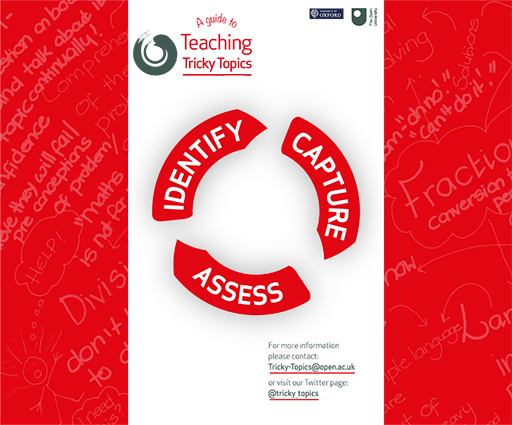2 The tricky topics process
Armed with a knowledge of the difficulties that students have in certain topics and having learned the difference between a tricky topic, a stumbling block and a problem example, this section will look at how you actually go about identifying and breaking down a tricky topic in practice in order to deal with it appropriately.
The tricky topics process has three main stages:
- Identify: a set of collaborative group activities in which teachers will be encouraged to think of a tricky topic and break it down into assessable parts.
- Capture: capture the problem examples and use the problem distiller to help to uncover why students find these tricky. This helps to define the stumbling blocks in more detail in order to be able to assess them.
- Assess: multiple activities to guide teachers to develop interventions which help to overcome the stumbling blocks and to create quiz questions which fully assess the stumbling blocks and evaluate the intervention.
In the next activity you will go to the tricky topics guide, the website dedicated to helping teachers (both experienced and trainee) to perform the tricky topics process. You will record your reflections on IRIS Connect.
Activity 3 The teaching tricky topics guide
Go to The tricky topics guide [Tip: hold Ctrl and click a link to open it in a new tab. (Hide tip)] on the website.
Read through the different steps in the tricky topics process. Pay particular attention to Step 3 (Mind Maps).
You can also explore this information on our tricky topics group on IRIS Connect. Just head to the ‘tricky topic process’ tab.
- Write a few sentences about your thoughts on the tricky topics process (using the questions below as a guide) in the comment box below or on IRIS Connect under Week 3, Activity 3.
- Did it make sense to you?
- Is it something you have done before or something you feel you can do now?
- How could this process be applied to your own practice?
- How does this relate to your experiences previously or your thought about the needs analysis last week?
Did you see the different structure charts in the guide? Did you recognise the optics and ray diagram mind map? The identify and capture stages of the tricky topics process will be used this week, which will take us up to Step 6 in the guide. The Assess stage with its interventions and quizzes will be dealt with in the next few weeks of this course.

